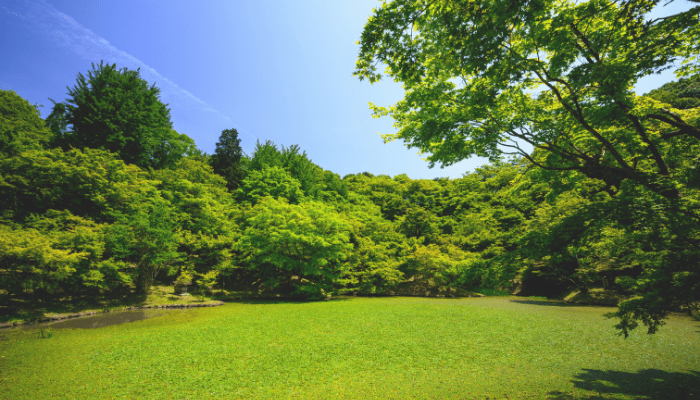Key Takeaways
- Organic pools use plants, not chemicals, to keep water clean and naturally beautiful.
- Eco‑friendly and skin‑safe, they create a backyard ecosystem that supports wildlife.
- Higher upfront cost, lower upkeep, with minimal maintenance once established.
- Smart design is key: plenty of sun, balanced planting, and good circulation.
- DIY or pro builds work, and common issues like algae are easy to manage.
- A sustainable, stunning alternative to traditional chlorine pools.
More and more homeowners are swapping traditional chlorinated pools for natural swimming havens. Why? Because organic pools are not only beautiful but also eco-friendly, chemical-free, and incredibly low-maintenance!
Beyond their health benefits, organic pools blend beautifully into a garden’s landscape, creating a backyard oasis that feels much more like a retreat than a standard pool. Whether you’re looking for a sustainable alternative or simply love the idea of swimming in pure, living water – organic pools offer the perfect balance of beauty and function. Let’s dive straight in!

What Is an Organic Pool?
Unlike traditional pools that rely on chlorine and other chemicals, organic pools use nature’s own filtration system to keep the water clean and crystal clear. Think of it as having a living, breathing ecosystem in your backyard – one that supports both people and nature!
At its core, an organic pool typically consists of two main sections:
- The Swimming Area – This is where you enjoy the water, just like a traditional pool
- The Regeneration Zone – Instead of chemical filtration, this area is filled with aquatic plants, gravel, and beneficial microorganisms that naturally clean the water
Water continuously cycles between these two zones, allowing the plants and biofilters to remove debris and harmful bacteria – just like how lakes and ponds maintain their own balance in the wild. The result? Pristine water that feels soft on your skin, smells fresh, and looks breathtakingly beautiful!

Sustainability Benefits of Organic Pools
Beyond simply being a gorgeous backyard feature, organic pools offer significant environmental benefits:
- No Harsh Chemicals – say goodbye to chlorine irritation and that strong chemical smell
- Supports Biodiversity – the natural filtration system encourages birds, butterflies and beneficial insects to visit, creating a mini ecosystem
- Lower Long-Term Costs – while the initial setup might be an investment, organic pools require less maintenance, reducing ongoing costs
- Energy Efficient – no need for energy-intensive filtration systems – nature does the work for you!
With an organic pool, you’re not just swimming – you’re immersing yourself in nature while making an eco-conscious choice! Some companies like Oásis Biosistema take innovative sustainability for natural swimming a step further; their unique approach blends traditional pond-like designs with advanced mechanical filtration, using a specialised sump system to keep water crystal clear. By integrating both plants and fish for biological balance – while also incorporating UV light and ozone treatments – they ensure minimal maintenance and pristine water quality year-round.

How to Build an Organic Pool
Creating your own organic pool might seem overwhelming at first – but with the right plan it’s totally doable (whether you’re going the DIY route or hiring a professional). Here’s how to make your vision a reality.
Planning & Designing Your Organic Pool
Before you grab a shovel, take some time to plan. Think about how you want your pool to both look and function; do you want a natural pond aesthetic or something more modern? Will it be for swimming, relaxing, or both?
Sketching out a rough design can help you begin to visualize the final result. For more detailed inspiration, check out our blog on our favourite pool design ideas!
Choosing the Right Location & Size
Placement is everything! Ideally, your pool should get plenty of sunlight to help the plants thrive and keep the water warm. Also, consider nearby trees – too many can mean extra debris in the water. As for size, organic pools can be customized to fit any space, but a good rule of thumb is to have at least half of the pool dedicated to regeneration (where plants help filter the water).
Selecting Aquatic Plants & Filtration Components
Here’s where nature does the heavy lifting! Aquatic plants, gravel, and biofilters work together to keep the water clean and balanced. You’ll need a mix of submerged plants (like hornwort) and floating plants (like water lilies) to help oxygenate and filter the water naturally. Adding a small pump or aeration system can also help with circulation.
The most modern, advanced systems combine natural filtration with sump chambers filled with Japanese mats, brushes, and specialized media. This combination enhances water clarity without relying solely on plants, making it ideal for those who want a clean, low-maintenance solution!
Step-by-Step Installation Guide
Once your design is ready, it’s time to start digging! Here’s a basic rundown of the process:
- Excavate your pool area, creating separate zones for swimming and plant filtration
- Line the pool with a durable, eco-friendly liner to prevent water loss
- Build the filtration area, adding gravel, plants, and any necessary plumbing for circulation
- Fill the pool with fresh water and let nature take over! The ecosystem may take a few weeks to fully balance, but soon, you’ll have clear, swimmable water – completely free of chlorine!

Organic Pools vs. Traditional Pools
Choosing between an organic pool and a traditional chlorine pool is essentially deciding between a lush, natural oasis and a crisp, chemically-controlled swim. Both have their perks, but it all comes down to what matters most to you!
Cost
Traditional pools usually have a lower upfront price, but the long-term costs of chemicals, filtration, and maintenance add up. Organic pools may cost more initially, but they save you money over time with minimal upkeep.
Maintenance
Traditional pools also require constant chemical balancing, while organic pools rely on nature – plants and biofilters do the work for you! To keep your water crystal clear, ensure a healthy balance of aquatic plants and beneficial bacteria. Occasional skimming, plant trimming, and natural filtration adjustments will also keep your pool thriving!
Water quality
Traditional pools can leave your skin dry and eyes red, thanks to the presence of chlorine. Organic pools? They feel like swimming in a fresh, natural lake – gentle on the skin, no harsh chemicals and crystal-clear water.

Common Challenges & Simple Solutions
Owning an organic pool is a dream, but like anything natural, it comes with a few quirks! Here’s how to tackle the most common challenges:
Algae Control & Water Clarity
- Ensure proper water circulation with pumps or gentle waterfalls
- Add the right mix of aquatic plants to absorb excess nutrients
- Keep debris out with a skimmer or net to prevent algae growth
Managing Insects & Wildlife
- Encourage dragonflies and frogs – they naturally control pests!
- Use moving water (like a small fountain) to deter mosquitoes
Winter Care for Organic Pools
- Trim back plants and remove excess debris before freezing temps
- Let your pool go dormant – nature will take care of itself!
Conclusion
Organic pools offer a beautiful, sustainable alternative to traditional swimming pools! While they do require some initial investment and care, the long-term benefits – such as low maintenance and eco-friendliness – make them a great choice for nature lovers and those seeking a healthier way to swim.
Ready to dive in? Whether you’re considering a DIY project or seeking professional help from specialists in advanced natural filtration systems, explore the many options for creating your own organic pool!
FAQ
Are organic pools safe for swimming?
Yes, they’re safe! They use natural filtration and are free from harmful chemicals.
Do organic pools require maintenance?
Yes, but less than traditional pools – regular plant care and water monitoring are needed!
How much does it cost to build an organic pool?
Typically between $50,000 and $100,000, with lower long-term maintenance costs.
Can I convert my existing pool into an organic pool?
Yes, with adjustments to filtration and design.
What plants are best for organic pool filtration?
Water lilies, cattails, and water hyacinths are great choices!
Will an organic pool attract mosquitoes?
No, if properly maintained with good circulation and plant selection.



